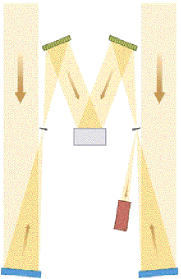Aaron J. Hand
The first large-scale space mission to be fully planned and operated by a university's academic department has taken some final steps toward its planned February 1999 launch.

The Far Ultraviolet Spectroscopic Explorer was shipped in August from Johns Hopkins University's Applied Physics Laboratory to NASA's Goddard Space Flight Center in Greenbelt, Md., for testing. The university's Center for Astrophysical Sciences, which designed and developed the satellite, will take control of it after launch and manage it throughout the expected three-year mission.
In low Earth orbit, the satellite will investigate the galaxy in the far-UV region of about 90 to 120 nm, uncovering secrets of galaxy evolution and star formation. The instrument can view a part of the spectrum unseen by the Hubble Space Telescope or x-ray telescopes, and has a much higher resolution and sensitivity than previous far-UV instruments.
Some essential atoms and molecules are best seen in the far-UV, according to Warren Moos, professor of physics and astronomy at Johns Hopkins and principal investigator for the mission.
For example, the instrument will measure the concentration of deuterium -- a fossil nucleus left over from the Big Bang -- to see how much has been destroyed by stellar processes. The satellite also will be extremely sensitive to molecular hydrogen, one of the basic materials out of which stars are formed. And it will look at hot ionized oxygen caused by supernovas.
"This spectral region permits us to see the motion of hot gas at many hundreds of thousands of degrees both in the disc of the galaxy and in the halo of the galaxy," Moos said.
Extreme sensitivity
The instrument consists of four aligned telescopes. Light from the stars is focused by four curved mirrors onto four spherical, aberration-corrected holographic diffraction gratings, then recorded by two delay-line microchannel plate detectors. Two of the optical channels are coated with lithium fluoride and cover 100 to 120 nm, and the other two are coated with silicon carbide (SiC) and cover 90 to 110 nm.
The instrument is at least 10,000 times more sensitive than Copernicus, which observed far-UV light during the 1970s. Playing a large part in this sensitivity, Moos said, is the 180-mm coverage along the spectrum of the microchannel plate detectors, developed by the University of California at Berkeley.
"As detector technology goes, when you realize that you're reading out a pixel every 6 µm, that's a very large and complex detector," he said.
Also, Copernicus could look at only one wavelength at a time, Moos said, and this latest instrument will look at all the wavelengths at once. The two SiC-coated telescopes also play a big role. "Copernicus was very sensitive down to about 1000 Å, but in fact for the transitions of deuterium we're interested in, most transitions fall below 1000 Å," he said.
The satellite, put together at Johns Hopkins, includes optics made by several international corporate and academic entities. The approximately 30 x 30-cm holographic gratings were developed by the Laboratoire d'Astronomie Spatiale in Marseilles, France; the telescope mirrors were made by Tinsley Laboratories Inc. in Richmond, Calif.; the fine-error sensor, a charge-coupled device camera that helps point the instrument, was made by Canada's ComDev in Cambridge, Ontario, and provided by the Canadian Space Agency; and the University of Colorado in Boulder aligned the spectrographs.
